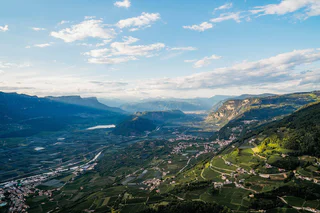
Lake Kaltern Path
Sella/Söll, Tramin an der Weinstraße/Termeno sulla Strada del Vino, Alto Adige Wine Road
Obujte si turistické boty a prozkoumejte krajinu podél jihotyrolské vinařské stezky. Tyto tipy na výlety vás zavedou po klikatých cestách, přes malebné vinice a půvabné vesničky až na bezstarostná panoramatická místa. Od nenáročných procházek až po náročné túry - každý si zde najde doslova to své. Dokonalá kombinace požitku z přírody a kultury při vychutnávání místních vín a vřelé pohostinnosti charakterizuje Jihotyrolskou vinařskou stezku jako turistickou oblast pro znalce.

Sella/Söll, Tramin an der Weinstraße/Termeno sulla Strada del Vino, Alto Adige Wine Road

1/4
Mazzon/Mazon, Neumarkt/Egna, Alto Adige Wine Road

1/2
Caldaro Campi al lago/Kalterer Klughammer, Kaltern an der Weinstraße/Caldaro sulla Strada del Vino, Alto Adige Wine Road

Pinzano/Pinzon, Montan/Montagna, Alto Adige Wine Road

Laghetti/Laag, Neumarkt/Egna, Alto Adige Wine Road

1/8
Avenes/Afens, Pfitsch/Val di Vizze, Alto Adige Wine Road

1/3
Ronchi/Rungg - Termeno/Tramin, Tramin an der Weinstraße/Termeno sulla Strada del Vino, Alto Adige Wine Road

1/10
Salorno/Salurn, Alto Adige Wine Road

Caldaro Paese/Kaltern Dorf, Kaltern an der Weinstraße/Caldaro sulla Strada del Vino, Alto Adige Wine Road

1/7
S. Giuseppe al Lago/St. Josef am See, Kaltern an der Weinstraße/Caldaro sulla Strada del Vino, Alto Adige Wine Road

Laghetti/Laag, Neumarkt/Egna, Alto Adige Wine Road

1/12
Castelvecchio/Altenburg, Kaltern an der Weinstraße/Caldaro sulla Strada del Vino, Alto Adige Wine Road

1/3
Cortaccia s.S.d.V./Kurtatsch, Kurtatsch an der Weinstraße/Cortaccia sulla Strada del Vino, Alto Adige Wine Road

1/3
Salorno/Salurn, Alto Adige Wine Road

Mendelpass, Kaltern an der Weinstraße/Caldaro sulla Strada del Vino, Alto Adige Wine Road

1/5
Tramin an der Weinstraße/Termeno sulla Strada del Vino, Alto Adige Wine Road

1/11
Andriano/Andrian, Andrian/Andriano, Alto Adige Wine Road

1/3
Monticolo/Montiggl, Kaltern an der Weinstraße/Caldaro sulla Strada del Vino, Alto Adige Wine Road

Riva di Sotto/Unterrain, Eppan an der Weinstaße/Appiano sulla Strada del Vino, Alto Adige Wine Road

1/5
Andriano/Andrian, Andrian/Andriano, Alto Adige Wine Road

1/4
Pinzano/Pinzon, Montan/Montagna, Alto Adige Wine Road

1/5
Ora/Auer, Auer/Ora, Alto Adige Wine Road

Ora/Auer, Auer/Ora, Alto Adige Wine Road

1/4
Salorno/Salurn, Alto Adige Wine Road

1/4
Sella/Söll, Tramin an der Weinstraße/Termeno sulla Strada del Vino, Alto Adige Wine Road

1/4
Cortaccia s.S.d.V./Kurtatsch, Kurtatsch an der Weinstraße/Cortaccia sulla Strada del Vino, Alto Adige Wine Road

Castelvecchio/Altenburg, Kaltern an der Weinstraße/Caldaro sulla Strada del Vino, Alto Adige Wine Road

1/2
Cortaccia s.S.d.V./Kurtatsch, Kurtatsch an der Weinstraße/Cortaccia sulla Strada del Vino, Alto Adige Wine Road

Cortina s.s.d.V./Kurtinig, Kurtinig an der Weinstraße/Cortina sulla Strada del Vino, Alto Adige Wine Road

Ronchi/Rungg - Termeno/Tramin, Tramin an der Weinstraße/Termeno sulla Strada del Vino, Alto Adige Wine Road